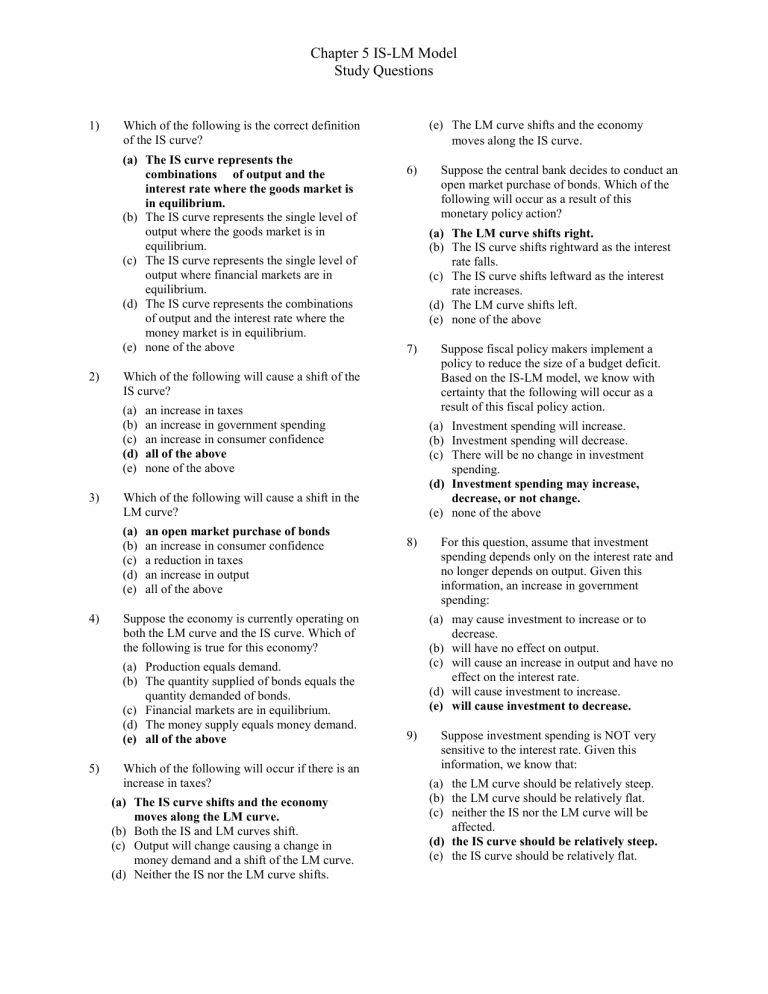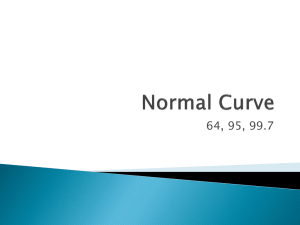Chapter 5 IS-LM Model Study Questions 1) Which of the following is
advertisement

Chapter 5 IS-LM Model Study Questions 1) (a) The IS curve represents the combinations of output and the interest rate where the goods market is in equilibrium. (b) The IS curve represents the single level of output where the goods market is in equilibrium. (c) The IS curve represents the single level of output where financial markets are in equilibrium. (d) The IS curve represents the combinations of output and the interest rate where the money market is in equilibrium. (e) none of the above 2) Which of the following will occur if there is an increase in taxes? (a) The IS curve shifts and the economy moves along the LM curve. (b) Both the IS and LM curves shift. (c) Output will change causing a change in money demand and a shift of the LM curve. (d) Neither the IS nor the LM curve shifts. Suppose fiscal policy makers implement a policy to reduce the size of a budget deficit. Based on the IS-LM model, we know with certainty that the following will occur as a result of this fiscal policy action. (a) Investment spending will increase. (b) Investment spending will decrease. (c) There will be no change in investment spending. (d) Investment spending may increase, decrease, or not change. (e) none of the above 8) Suppose the economy is currently operating on both the LM curve and the IS curve. Which of the following is true for this economy? (a) Production equals demand. (b) The quantity supplied of bonds equals the quantity demanded of bonds. (c) Financial markets are in equilibrium. (d) The money supply equals money demand. (e) all of the above 5) 7) an increase in taxes an increase in government spending an increase in consumer confidence all of the above none of the above an open market purchase of bonds an increase in consumer confidence a reduction in taxes an increase in output all of the above Suppose the central bank decides to conduct an open market purchase of bonds. Which of the following will occur as a result of this monetary policy action? (a) The LM curve shifts right. (b) The IS curve shifts rightward as the interest rate falls. (c) The IS curve shifts leftward as the interest rate increases. (d) The LM curve shifts left. (e) none of the above Which of the following will cause a shift in the LM curve? (a) (b) (c) (d) (e) 4) 6) Which of the following will cause a shift of the IS curve? (a) (b) (c) (d) (e) 3) (e) The LM curve shifts and the economy moves along the IS curve. Which of the following is the correct definition of the IS curve? For this question, assume that investment spending depends only on the interest rate and no longer depends on output. Given this information, an increase in government spending: (a) may cause investment to increase or to decrease. (b) will have no effect on output. (c) will cause an increase in output and have no effect on the interest rate. (d) will cause investment to increase. (e) will cause investment to decrease. 9) Suppose investment spending is NOT very sensitive to the interest rate. Given this information, we know that: (a) the LM curve should be relatively steep. (b) the LM curve should be relatively flat. (c) neither the IS nor the LM curve will be affected. (d) the IS curve should be relatively steep. (e) the IS curve should be relatively flat. Chapter 5 IS-LM Model Study Questions 10) A reduction in the money supply will cause a reduction in which of the following variables? (a) (b) (c) (d) (e) 11) 12) output increases output decreases the interest rate decreases both output and the interest rate increase the interest rate increases Suppose there is a Fed purchase of bonds and simultaneous tax cut. We know with certainty that this combination of policies must cause: (a) (b) (c) (d) 15) the interest rate decreases both output and the interest rate increase output decreases the interest rate increases output increases Suppose there is a simultaneous tax increase and open market purchase of bonds. Which of the following must occur as a result of this? (a) (b) (c) (d) (e) 14) consumption and output consumption, investment and output consumption consumption and investment consumption, output and the interest rate Suppose there is a simultaneous tax cut and open market purchase of bonds. Which of the following must occur as a result of this? (a) (b) (c) (d) (e) 13) consumption investment output all of the above none of the above Suppose there is an increase in consumer confidence. Which of the following represents the complete list of variables that must increase in response to this increase in consumer confidence? (a) (b) (c) (d) (e) an increase in the interest rate (i). a reduction in i. an increase in output (Y). a reduction in Y. We know with certainty that a tax increase must cause which of the following? (a) (b) (c) (d) 16) an increase in investment no change in investment a reduction in investment none of the above An increase in the reserve deposit ratio, q, will most likely have which of the following effects? (a) (b) (c) (d) 17) The IS curve will NOT shift when which of the following occurs? (a) (b) (c) (d) (e) 18) a rightward shift in the IS curve a leftward shift in the IS curve an leftward shift in the LM curve a rightward shift in the LM curve a reduction in government spending a reduction in consumer confidence a reduction in the interest rate all of the above none of the above For this question, assume that investment spending depends only on output and no longer depends on the interest rate. Given this information, an increase in government spending: (a) will cause investment to increase. (b) may cause investment to increase or to decrease. (c) will have no effect on output. (d) will cause an increase in output and have no effect on the interest rate. (e) will cause investment to decrease.






